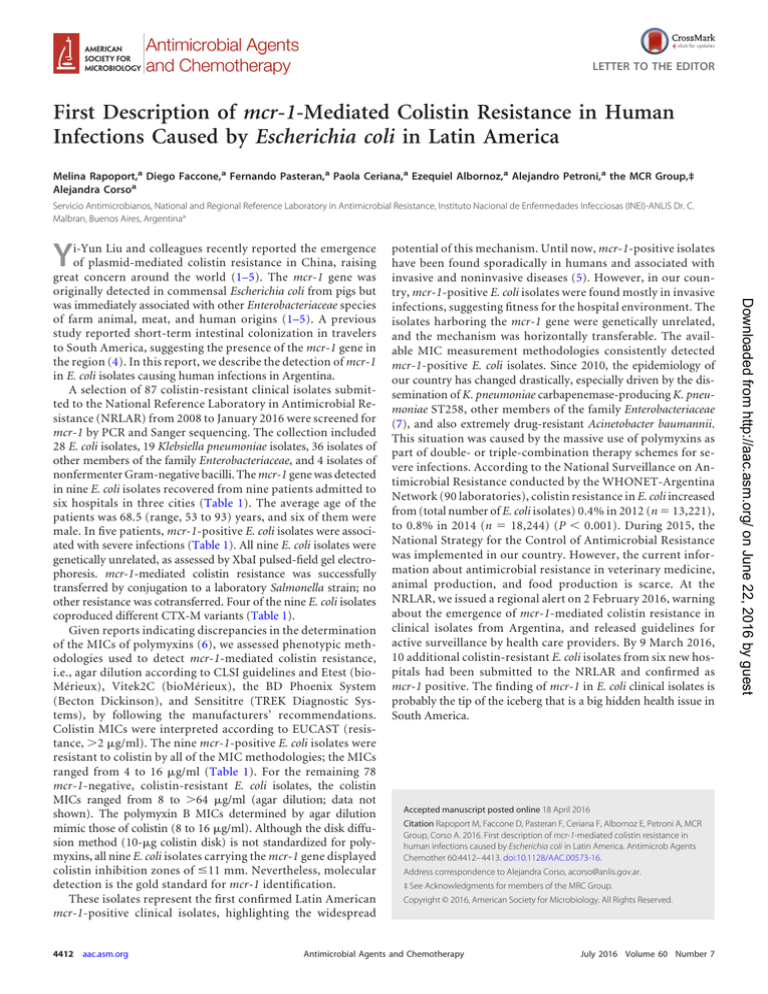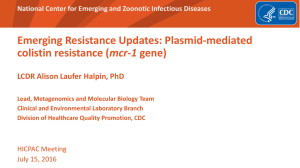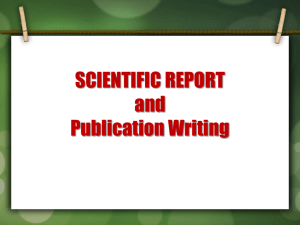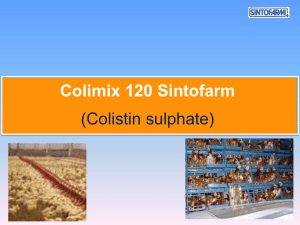
crossmark
LETTER TO THE EDITOR
First Description of mcr-1-Mediated Colistin Resistance in Human
Infections Caused by Escherichia coli in Latin America
Melina Rapoport,a Diego Faccone,a Fernando Pasteran,a Paola Ceriana,a Ezequiel Albornoz,a Alejandro Petroni,a the MCR Group,‡
Alejandra Corsoa
Servicio Antimicrobianos, National and Regional Reference Laboratory in Antimicrobial Resistance, Instituto Nacional de Enfermedades Infecciosas (INEI)-ANLIS Dr. C.
Malbran, Buenos Aires, Argentinaa
Y
4412
aac.asm.org
potential of this mechanism. Until now, mcr-1-positive isolates
have been found sporadically in humans and associated with
invasive and noninvasive diseases (5). However, in our country, mcr-1-positive E. coli isolates were found mostly in invasive
infections, suggesting fitness for the hospital environment. The
isolates harboring the mcr-1 gene were genetically unrelated,
and the mechanism was horizontally transferable. The available MIC measurement methodologies consistently detected
mcr-1-positive E. coli isolates. Since 2010, the epidemiology of
our country has changed drastically, especially driven by the dissemination of K. pneumoniae carbapenemase-producing K. pneumoniae ST258, other members of the family Enterobacteriaceae
(7), and also extremely drug-resistant Acinetobacter baumannii.
This situation was caused by the massive use of polymyxins as
part of double- or triple-combination therapy schemes for severe infections. According to the National Surveillance on Antimicrobial Resistance conducted by the WHONET-Argentina
Network (90 laboratories), colistin resistance in E. coli increased
from (total number of E. coli isolates) 0.4% in 2012 (n ⫽ 13,221),
to 0.8% in 2014 (n ⫽ 18,244) (P ⬍ 0.001). During 2015, the
National Strategy for the Control of Antimicrobial Resistance
was implemented in our country. However, the current information about antimicrobial resistance in veterinary medicine,
animal production, and food production is scarce. At the
NRLAR, we issued a regional alert on 2 February 2016, warning
about the emergence of mcr-1-mediated colistin resistance in
clinical isolates from Argentina, and released guidelines for
active surveillance by health care providers. By 9 March 2016,
10 additional colistin-resistant E. coli isolates from six new hospitals had been submitted to the NRLAR and confirmed as
mcr-1 positive. The finding of mcr-1 in E. coli clinical isolates is
probably the tip of the iceberg that is a big hidden health issue in
South America.
Accepted manuscript posted online 18 April 2016
Citation Rapoport M, Faccone D, Pasteran F, Ceriana F, Albornoz E, Petroni A, MCR
Group, Corso A. 2016. First description of mcr-1-mediated colistin resistance in
human infections caused by Escherichia coli in Latin America. Antimicrob Agents
Chemother 60:4412– 4413. doi:10.1128/AAC.00573-16.
Address correspondence to Alejandra Corso, acorso@anlis.gov.ar.
‡ See Acknowledgments for members of the MRC Group.
Copyright © 2016, American Society for Microbiology. All Rights Reserved.
Antimicrobial Agents and Chemotherapy
July 2016 Volume 60 Number 7
Downloaded from http://aac.asm.org/ on June 22, 2016 by guest
i-Yun Liu and colleagues recently reported the emergence
of plasmid-mediated colistin resistance in China, raising
great concern around the world (1–5). The mcr-1 gene was
originally detected in commensal Escherichia coli from pigs but
was immediately associated with other Enterobacteriaceae species
of farm animal, meat, and human origins (1–5). A previous
study reported short-term intestinal colonization in travelers
to South America, suggesting the presence of the mcr-1 gene in
the region (4). In this report, we describe the detection of mcr-1
in E. coli isolates causing human infections in Argentina.
A selection of 87 colistin-resistant clinical isolates submitted to the National Reference Laboratory in Antimicrobial Resistance (NRLAR) from 2008 to January 2016 were screened for
mcr-1 by PCR and Sanger sequencing. The collection included
28 E. coli isolates, 19 Klebsiella pneumoniae isolates, 36 isolates of
other members of the family Enterobacteriaceae, and 4 isolates of
nonfermenter Gram-negative bacilli. The mcr-1 gene was detected
in nine E. coli isolates recovered from nine patients admitted to
six hospitals in three cities (Table 1). The average age of the
patients was 68.5 (range, 53 to 93) years, and six of them were
male. In five patients, mcr-1-positive E. coli isolates were associated with severe infections (Table 1). All nine E. coli isolates were
genetically unrelated, as assessed by XbaI pulsed-field gel electrophoresis. mcr-1-mediated colistin resistance was successfully
transferred by conjugation to a laboratory Salmonella strain; no
other resistance was cotransferred. Four of the nine E. coli isolates
coproduced different CTX-M variants (Table 1).
Given reports indicating discrepancies in the determination
of the MICs of polymyxins (6), we assessed phenotypic methodologies used to detect mcr-1-mediated colistin resistance,
i.e., agar dilution according to CLSI guidelines and Etest (bioMérieux), Vitek2C (bioMérieux), the BD Phoenix System
(Becton Dickinson), and Sensititre (TREK Diagnostic Systems), by following the manufacturers’ recommendations.
Colistin MICs were interpreted according to EUCAST (resistance, ⬎2 g/ml). The nine mcr-1-positive E. coli isolates were
resistant to colistin by all of the MIC methodologies; the MICs
ranged from 4 to 16 g/ml (Table 1). For the remaining 78
mcr-1-negative, colistin-resistant E. coli isolates, the colistin
MICs ranged from 8 to ⬎64 g/ml (agar dilution; data not
shown). The polymyxin B MICs determined by agar dilution
mimic those of colistin (8 to 16 g/ml). Although the disk diffusion method (10-g colistin disk) is not standardized for polymyxins, all nine E. coli isolates carrying the mcr-1 gene displayed
colistin inhibition zones of ⱕ11 mm. Nevertheless, molecular
detection is the gold standard for mcr-1 identification.
These isolates represent the first confirmed Latin American
mcr-1-positive clinical isolates, highlighting the widespread
Letter to the Editor
Characteristic
July 2012
Neurologic
disease
Blood
1
M15049
16
16
Urine
2
Oct. 2012
Diabetes
M15224
The MCR Group includes the following: María Laura Maldonado and
Celeste Lucero, NRLAR, INEI-ANLIS Dr. C. Malbrán, Buenos Aires, Argentina; Flavia Amalfa, Hospital General de Agudos Parmenio Piñero,
Buenos Aires City, Argentina; Maria Susana Aiassa, Hospital Córdoba,
Córdoba, Argentina; Laura Errecalde and Sara Kauffman, Hospital General de Agudos Dr. Juan A. Fernández, Buenos Aires City, Argentina;
Manuel Arturo López, Hospital Luis Carlos Lagomaggiore, Mendoza, Argentina; Andrea Vila and Hugo Pagella, Hospital Italiano de Mendoza,
Mendoza, Argentina; and Graciela Greco, Hospital Italiano, Buenos Aires
City, Argentina.
We have no competing interests to declare.
FUNDING INFORMATION
This work was supported by the regular federal budget of the National
Ministry of Health of Argentina.
REFERENCES
M17056
M19736
M19855
Salmonella
sp. strain
TC-M19736
Abscess
6
M19441
July 2015
Rheumatoid arthritis
Nov. 2015
Secondary peritonitis/
colon cancer
Blood
5
M19242
Apr. 2015
Heart failure
Bone
4
16
16
M19241
Mar. 2015
Prostate cancer
Urine (catheter)
3
8
8
Jan. 2016
NAa
Urine (catheter)
3
8
8
Nov. 2013
Urinary tract
infection
Blood
3
8
8
1. Liu Y-Y, Wang Y, Walsh TR, Yi LX, Zhang R, Spencer J, Doi Y, Tian G,
Dong B, Huang X, Yu LF, Gu D, Ren H, Chen X, Lv L, He D, Zhou H,
Liang Z, Liu JH, Shen J. 2016. Emergence of plasmid-mediated colistin
resistance mechanism MCR-1 in animals and human beings in China: a
microbiological and molecular biological study. Lancet Infect Dis 16:161–
168. http://dx.doi.org/10.1016/S1473-3099(15)00424-7.
2. Du H, Chen L, Tang YW, Kreiswirth BN. 2016. Emergence of the mcr-1
colistin resistance gene in carbapenem-resistant Enterobacteriaceae. Lancet
Infect Dis 16:287–288. http://dx.doi.org/10.1016/S1473-3099(16)00056-6.
3. Olaitan AO, Chabou S, Okdah L, Morand S, Rolain JM. 2016. Dissemination of the mcr-1 colistin resistance gene. Lancet Infect Dis 16:147. http:
//dx.doi.org/10.1016/S1473-3099(15)00540-X.
4. Arcilla MS, van Hattem JM, Matamoros S, Melles DC, Penders J, de Jong
MD, Schultsz C, COMBAT Consortium. 2016. Dissemination of the
mcr-1 colistin resistance gene. Lancet Infect Dis 16:147–149. http://dx.doi
.org/10.1016/S1473-3099(15)00541-1.
5. Skov RL, Monnet DL. 2016. Plasmid-mediated colistin resistance (mcr-1
gene): three months later, the story unfolds. Euro Surveill 21:30155. http:
//dx.doi.org/10.2807/1560-7917.ES.2016.21.9.30155.
6. Hindler JA, Humphries RM. 2013. Colistin MIC variability by method
for contemporary clinical isolates of multidrug-resistant Gram-negative
bacilli. J Clin Microbiol 51:1678 –1684. http://dx.doi.org/10.1128/JCM
.03385-12.
7. Gomez SA, Pasteran FG, Faccone D, Tijet N, Rapoport M, Lucero C,
Lastovetska O, Albornoz E, Galas M, Group KPC, Melano RG, Corso A,
Petroni A. 2011. Clonal dissemination of Klebsiella pneumoniae ST258
harbouring KPC-2 in Argentina. Clin Microbiol Infect 17:1520 –1524. http:
//dx.doi.org/10.1111/j.1469-0691.2011.03600.x.
Antimicrobial Agents and Chemotherapy
aac.asm.org
4413
Downloaded from http://aac.asm.org/ on June 22, 2016 by guest
M17059
Nov. 2013
Appendicitis
Abdomen
3
8
8
8
8
None
8
8
8
16
AMP, AMS, FGC, ESC,
AMP, AMS, CMP, CIP
CMP, GEN, MIN, CIP
None
AMP, AMS, FGC,
ESC, GEN,
MIN, CIP
CTX-M-14 group
CIP
AMP, CIP
None
CTX-M-15 group
None
AMP, AMS,
FGC, ESC,
TMS, GEN
CTX-M-2 group
AMP, AMS, FGC,
ESC, GEN,
MIN, CIP
CTX-M-14 group
TABLE 1 Characteristics of mcr-1-harboring E. coli isolates
Isolation date
Diagnostic/underlying
disease of patient
Isolation site
Hospital
8
8
E. coli isolate:
MIC (g/ml)b of:
Colistin
Polymyxin B
AMP, FGC, NIT,
MIN, TMS,
CIP, FOS
None
Additional
resistance(s)c
TET, TMS,
CIP,
FOS
None
ESBLd genes
a
NA, not available.
b
Susceptibility to colistin and polymyxin B was evaluated by agar dilution.
c
AMP, ampicillin; AMS, ampicillin-sulbactam; FGC, first-generation cephalosporins; ESC, extended-spectrum cephalosporins; TET, tetracycline; MIN, minocycline; TMS, trimethoprim-sulfamethoxazole; CIP, ciprofloxacin; FOS,
fosfomycin; NIT, nitrofurantoin; GEN, gentamicin; CMP, chloramphenicol.
d
ESBL, extended-spectrum -lactamase.
July 2016 Volume 60 Number 7
ACKNOWLEDGMENTS



